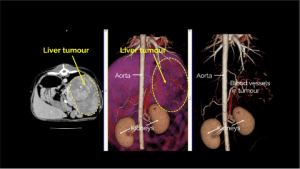Interventional Radiology
Back to Fact Sheets
Interventional Radiology (IR) is the 4th pillar of treatment for cancer patients, alongside surgery, radiation and chemotherapy/medical treatments.
Download PDF
Interventional Radiology (IR) is the 4th pillar of treatment for cancer patients, alongside surgery, radiation and chemotherapy/medical treatments.
IR allows the opportunity to improve pain control and quality of life in pets with cancer and can improve prognosis and outcomes in some patients.
The most common interventional procedures are outlined below:
Stenting
One of the most common IR procedures is stenting, which means placing a stent (a small tubular metal structure) inside an organ or vessel to relieve a blockage.
The most common indication in cancer patients is in pets with blocked urethras, in which the stent allows them to urinate past the tumour. Stents can also be used in the ureter to relieve blockages between the kidney and bladder and in the gastrointestinal tract for example colon (and oesophagus) or airway and blood vessels, even in the biliary tract.


Subcutaneous-Ureteral Bypass (SUB)
This is a device which is placed between the kidney and bladder to allow the passage of urine in the case of tumours blocking the ureter and may be used as an alternative to a stent in some patients.
Embolisation and Chemoemobolisation
This is the process by which the blood supply to the tumour is targeted by blocking it with some small beads, or another ‘embolic’ agent, which are sometimes mixed with chemotherapy. The aim being to cut the blood supply to the tumour off and stop it from growing.
In this procedure, a small catheter is inserted via a blood vessel until the tumour is reached, and the embolic agent is then squirted down the catheter which is then removed.
Embolisation techniques are used in solid organs, usually inside the abdomen, for example, to cut off the blood supply to liver tumours or prostate tumours.

Breaking down blood clots
Either application of thrombotic agents to the clot via a catheter or an older clot can be stented open if it is obstructing for the patient.
The type or types of intervention appropriate for your pet will be discussed with your oncologist. Our aim is always to improve or maintain quality of life for our cancer patients.


